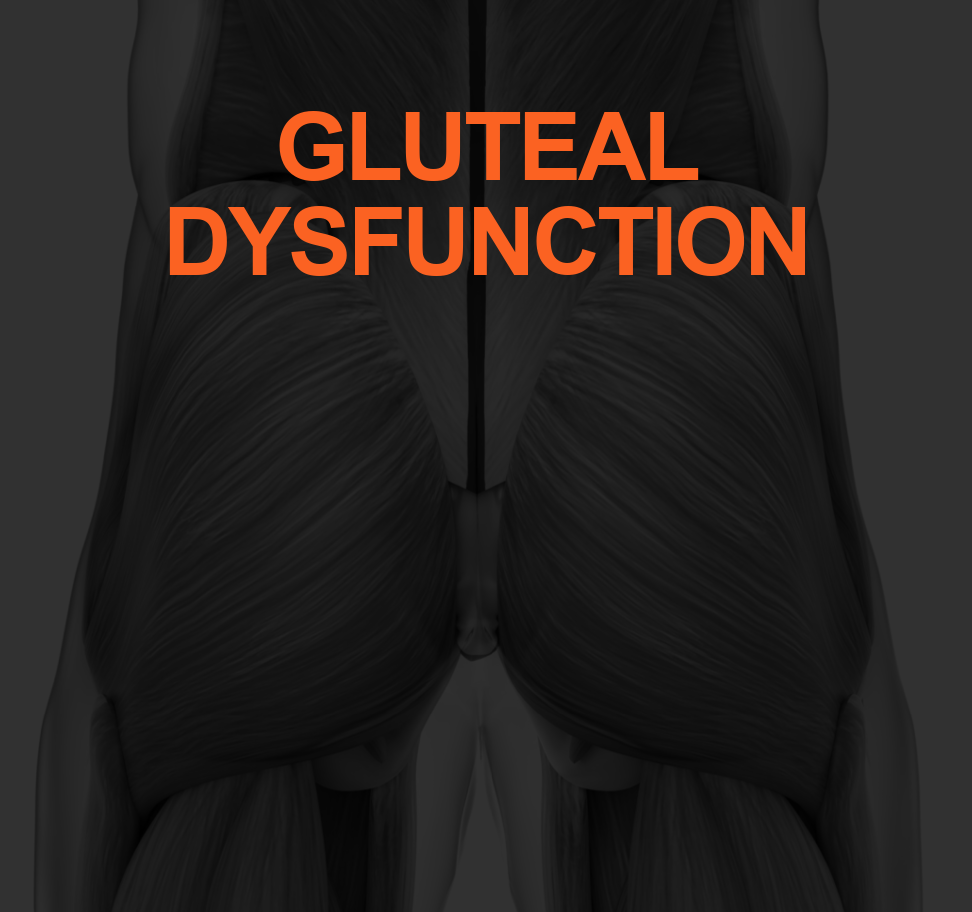Gluteal dysfunction can be a common problem among our personal training clients and can lead to a cascade of other kinetic chain issues if not corrected. The gluteal muscles—the largest in the body–are, in Old English, “protuberances which form the rump.” Each protuberance may weigh up to ~ 5 pounds, which is an enabler for an athlete’s explosive power in events like sprinting or Olympic Weight Lifts.
Clients perform better in strength, stamina, stability, and stretching regimens when their gluteal muscles are activated1 and strong. Two community benchmarks for relative gluteal strength are:
- A client is considered to be glute-strong when she or he can properly perform around 30+ donkey kicks from a quadruped stance
- A client is also glute-strong when she or he can perform a 1RM hip thrust with over 185lbs for women and over 250 pounds for men (1RM).
Even if clients are more interested in the aesthetics of gluteal shape than strength, it might help them to understand that mindful and proper gluteal activation to build functional strength of this powerhouse muscle group is the sure path to muscle development.
The If’s, And’s, and Butts
Three gluteal muscles are formed by eight skeletal muscle sections in each buttock. Their contractions and linkages to the pelvis and femur enable or support most human motions from our armpits to our knees.
For completeness, we should also consider regional muscles like the piriformis which can become a common source of backside or leg pain, and the psoas, which can create a hip flexor dominance, weakening the gluteal’s contraction. This author can speak with personal experience on both sciatica and piriformis syndrome2, also known as Deep Gluteal Symptom. This neuromuscular disorder occurs when our long sciatic nerve is irritated by the deep piriformis muscle in either buttock. As our National Institute of Health advises, piriformis syndrome is quite common (with 3 million cases reported annually) and may last months to become a chronic pain in the ar$e – even with medical care.
Sources of Gluteal Dysfunction
Three examples of how gluteal dysfunction arises include:
- Lifestyle. A client may be inactive or spend an inordinate time in a sitting position, lengthening and weakening the muscles.
- Irritation. A client may experience a pain due to an irritated sciatic nerve that passes through each gluteal region.
- Tendinitis. Chronic sitting coupled with excessive cardio (like running) without sufficient strength training can create tendon inflammation when the glute muscles are called on to perform repetitive actions the connective tissues is not equipped for. The resultant tendinopathy can shut-down the muscle contractions, effectively inhibiting recruitment of the glutes.
When our gluteal actions are inhibited, they may “forget” their main purpose of supporting our pelvis and keeping our lumbo-pelvic hip complex (LPHC) in proper alignment. The medical term for this muscular forgetfulness triggered by tendinitis is Gluteus Medius Tendinopathy (GT). Many professional trainers may recognize these other synonyms for GT – namely Gluteal Amnesia, and/or Dormant Butt Syndrome (DBS).
One’s forgotten and under-appreciated glutes may become a major cause of lateral hip pain. Fact: GT, or Gluteal Amnesia, or DBS, is the most common tendinopathy in our lower body. Women are impacted more than men in activities of daily life such as their side-lying sleep and weight-bearing activities/trainer workouts. One NIH report3 states that twenty-five percent of women over age fifty can be affected by this tendinitis between a gluteus medius and hip.
Counter-actions
First, the simple, yet not easy approach for counteracting a sedentary lifestyle is to break up long periods of sitting. Lower body mobility actions may limit prospects for deep vein thrombosis (DVT) in addition to improving fitness.
If piriformis syndrome is suspected or confirmed, a client should strengthen and align the piriformis ranges of motion with special attention on correcting any loss of internal hip rotation.
To counter-act GT, a client should learn proper methods to activate the gluteal muscles.
-
- Certain methods for glute activation and strengthening as is practiced in yoga will help a client create a mind-muscle connection.
- Improving hip stability is paramount for total gluteal strength
- As cited by Neto et al1, a trainer should prudently pick and choose from among sixteen (16) exercises that promote maximum activity for the Gluteus Maximus (Gmax) in each buttock.
Note: We face a slight misconception that complex exercises like back squats, lunges, and traditional deadweight lifts will optimally develop one’s gluteal muscle groups. Granted, the glutes are kinetically involved in these exercises, but if the quads and/or hamstrings are dominant and glutes are “sleepy” their recruitment is effectively diminished.
Pinch, Touch, Oppose, Work 3-D
Details of focused exercises that optimally activate our gluteals for top performance and injury avoidance will be provided in a future article. These four takeaways should help a client overcome gluteal inhibition (GT) to improve performance.
- “Pinch your Glutes” cues power for nearly every exercise that hinges the LPHC or rotates a hip. Pinch!
- A client may touch the gluteal region during a core exercise to stimulate the mind-muscle connection.
- To oppose inhibited or dormant butts, a client should activate glutes by working opposing muscles like the Psoas (Glute Bridge) and Hamstrings (Good morning hip hinges).
- Specific Glute activation and strength training should include exercises for all three body planes – transverse, frontal, and sagittal.
References
(1) Neto, Walter Krause et al. “Gluteus Maximus Activation during Common Strength and Hypertrophy Exercises: A Systematic Review.” Journal of sports science & medicine vol. 19,1 195-203. 24 Feb. 2020
(2)Carro, Luis Perez et al. “Deep gluteal space problems: piriformis syndrome, ischiofemoral impingement and sciatic nerve release.” Muscles, ligaments and tendons journal vol. 6,3 384-396. 21 Dec. 2016, doi:10.11138/mltj/2016.6.3.384
(3) Ladurner, Andreas et al. “Treatment of Gluteal Tendinopathy: A Systematic Review and Stage-Adjusted Treatment Recommendation.” Orthopaedic journal of sports medicine vol. 9,7 23259671211016850. 29 Jul. 2021, doi:10.1177/23259671211016850



